|
• 2011 Growing Good Kids Award
• Eureka! Award, 2012 Gold Winner
• ALA Notable Children's Book
• Jane Addams Children's Book Award
• Orbis Pictus Award for Outstanding Nonfiction, Honor Book
• Notable Children's Books, Smithsonian Magazine
• Green Earth Book Award
• Best Children's Books of the Year, Outstanding Title
• Notable Books for a Global Society
• "Choices" Award
 "This moving depiction of ecological innovation centers on a project spearheaded by Dr. Gordon Sato to plant mangrove trees, which grow easily in salt water, in the village of Hargigo in the impoverished African nation of Eritrea. Graceful prose alternates with cumulative verse to relay the benefits that the trees provided for the community: "These are the fishermen/ Who catch the fish/ That swim in the roots,/ Of the mangrove trees." Resembling papier-mâché, Roth's textural mixed-media collages become increasingly lively as the new ecosystem flourishes. An extensive afterword, containing many photographs of Sato and the people of Hargigo, brings their hopeful story into sharp focus. Ages 6–11." "This moving depiction of ecological innovation centers on a project spearheaded by Dr. Gordon Sato to plant mangrove trees, which grow easily in salt water, in the village of Hargigo in the impoverished African nation of Eritrea. Graceful prose alternates with cumulative verse to relay the benefits that the trees provided for the community: "These are the fishermen/ Who catch the fish/ That swim in the roots,/ Of the mangrove trees." Resembling papier-mâché, Roth's textural mixed-media collages become increasingly lively as the new ecosystem flourishes. An extensive afterword, containing many photographs of Sato and the people of Hargigo, brings their hopeful story into sharp focus. Ages 6–11."
- starred review, Publishers Weekly

 "This is a true story set in a small village in Eritrea. “The families used to be hungry./Their animals were hungry too./But then things began to change.../all because of a tree.” In poignant text that alternates between cumulative verse and prose, Roth and Trumbore describe how Dr. Gordon Sato, a Japanese-American cell biologist, helped to relieve poverty and famine by planting mangrove trees in salt water. Tended mainly by women, the trees flourished and multiplied, supplying food for animals and fish that, in turn, provided food for the people. Roth’s large paper and fabric textured collages first reveal a barren village that is then gradually transformed as pots of mangrove seedlings are transplanted and become abundant mangrove forests. Depictions of women in colorfully patterned long dresses and head scarves, shepherds in capes and head coverings, and children playing outside houses “made of cloth, tin cans, and flattened iron” convey a sense of place and culture. The cumulative poem ends with an introduction to and picture of the smiling scientist himself: “This is Gordon,/Whose greatest wish/Is to help.../By planting trees,/Mangrove trees,/By the sea.” A lengthy afterword contains additional information about Dr. Sato and photos of him working with the local people. Pair this inspiring story with Donna Napoli’s Mama Miti: Wangari Maathai and the Trees of Kenya (S & S, 2010) to spark discussion about how one individual can improve the lives of others.–Marianne Saccardi, formerly at Norwalk Community College, CT
"This is a true story set in a small village in Eritrea. “The families used to be hungry./Their animals were hungry too./But then things began to change.../all because of a tree.” In poignant text that alternates between cumulative verse and prose, Roth and Trumbore describe how Dr. Gordon Sato, a Japanese-American cell biologist, helped to relieve poverty and famine by planting mangrove trees in salt water. Tended mainly by women, the trees flourished and multiplied, supplying food for animals and fish that, in turn, provided food for the people. Roth’s large paper and fabric textured collages first reveal a barren village that is then gradually transformed as pots of mangrove seedlings are transplanted and become abundant mangrove forests. Depictions of women in colorfully patterned long dresses and head scarves, shepherds in capes and head coverings, and children playing outside houses “made of cloth, tin cans, and flattened iron” convey a sense of place and culture. The cumulative poem ends with an introduction to and picture of the smiling scientist himself: “This is Gordon,/Whose greatest wish/Is to help.../By planting trees,/Mangrove trees,/By the sea.” A lengthy afterword contains additional information about Dr. Sato and photos of him working with the local people. Pair this inspiring story with Donna Napoli’s Mama Miti: Wangari Maathai and the Trees of Kenya (S & S, 2010) to spark discussion about how one individual can improve the lives of others.–Marianne Saccardi, formerly at Norwalk Community College, CT
- starred review, School Library Journal
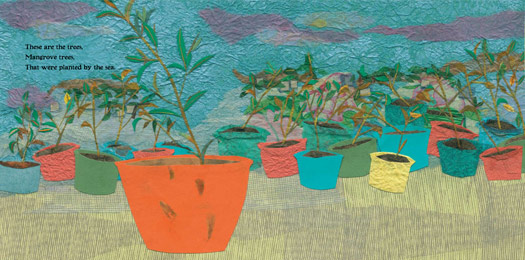
From an exhibit of the art from The Mangrove Tree in Flint, Michigan, at the Flint Institute of Art in May 2014 (where I also gave a lecture and directed a workshop for teachers):
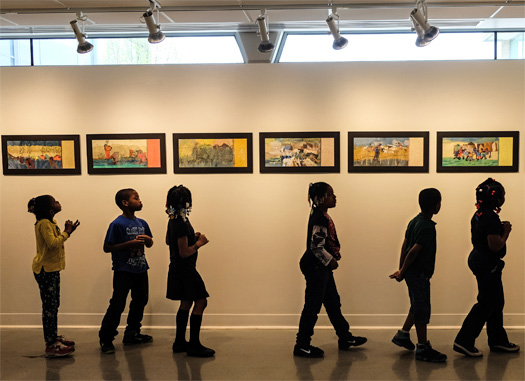
Mangrove Tree in Korean:
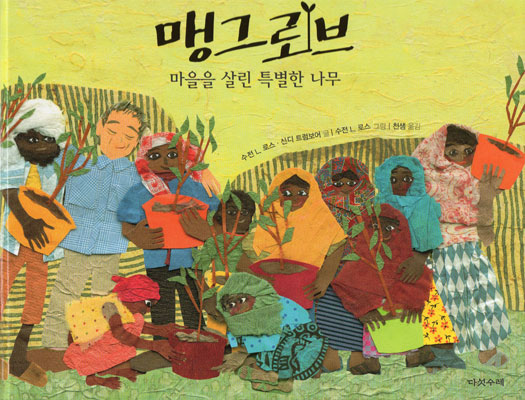
Mangrove Tree in Japanese:
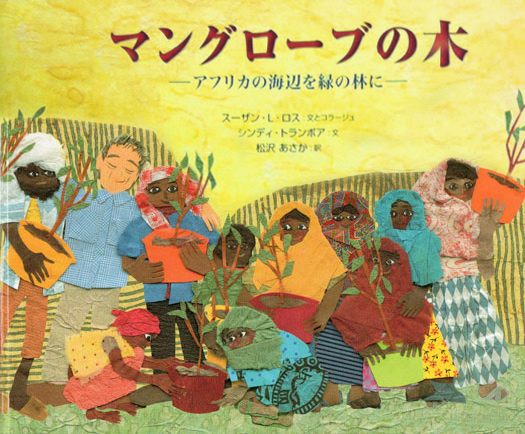
Mangrove Tree in Spanish:
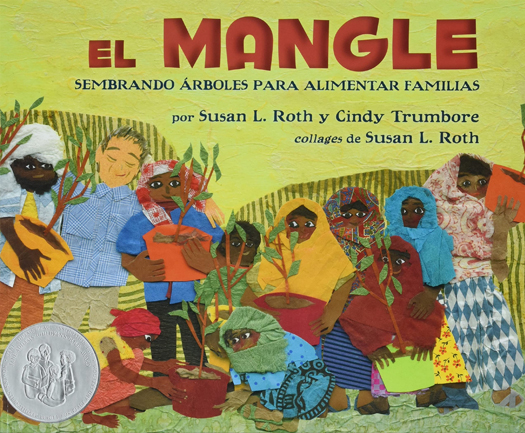
|